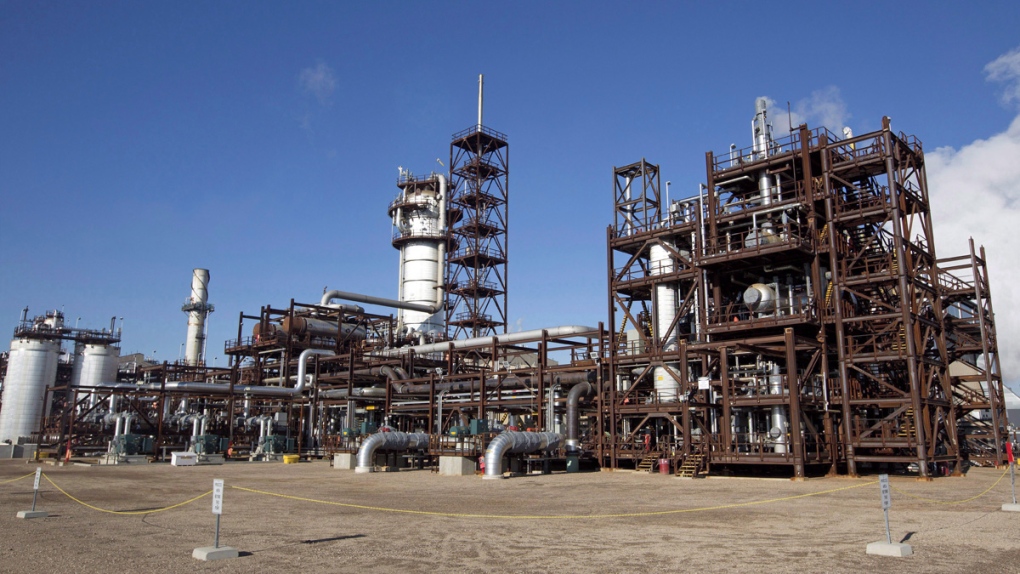Alberta green lights detailed study for 6 carbon storage hub projects around Edmonton
 Quest carbon capture and storage facility in Fort Saskatchewan Alta., on Nov. 6, 2015. (Jason Franson / THE CANADIAN PRESS)
Quest carbon capture and storage facility in Fort Saskatchewan Alta., on Nov. 6, 2015. (Jason Franson / THE CANADIAN PRESS)
Six new carbon storage hub projects have been granted the green light to move forward with development planning toward creating emission reduction projects in the industrial heartland around Edmonton.
The companies behind the projects, including Shell, Bison Low Carbon Ventures, Enbridge, and Pembina, will work with the province to ensure permanent carbon storage at their respective site and provide "open access to all emitters" and "affordable" hub usage rates.
"Carbon capture and storage is proven, safe and effective," said Sonya Savage, energy minister, in a statement.
"We are ensuring that carbon capture and sequestration will be deployed responsibility and strategically over the long term in the best interest of Albertans," Savage added. "This will help meet the increasing demand from industry and help significantly reduce emissions."
According to the province, only projects meeting "Alberta's rigorous safety and environmental standards" will be ultimately approved by the energy regulator.
The proposed projects include:
- Meadowbrook Hub Project north of Edmonton led by Bison Low Carbon Ventures Inc.;
- The Open Access Wabamun Carbon Hub west of Edmonton led by Enbridge Inc.;
- The Origins Project south of Edmonton led by Enhance Energy Inc.;
- Alberta Carbon Grid north and northeast of Edmonton led by Pembina Pipeline Corporation and TC Energy
- Altas Carbon Sequestration Hub (Atlas Hub) east of Edmonton led by Shell Canada Limited, ATCO Energy Solutions Ltd., and Suncor Energy Inc.; and
- An unnamed sequestration hub east of Edmonton led by Wolf Midstream and partners.
Exact locations will be determined during the regulatory review, and once comprehensive planning is completed, the province says.
The province is accepting further project proposals for carbon storage services until May 2.
Currently, Alberta has two large-scale carbon capture, utilization, and storage projects, Shell Canada's Quest plant and the Alberta Carbon Trunk Line.
The Quest facility, near Fort Saskatchewan, Alta., opened in 2015 and was designed to capture nearly one million tonnes of carbon dioxide annually from oil sands operations. The emissions are stored in a sandstone rock reservoir more than two kilometres underground.
The Alberta Carbon Trunk Line pumps captured carbon from several participating refineries and other industrial plants to old oil reservoirs for storage or future use. At full capacity, ACTL says the pipeline can transport 14.6 million tonnes of carbon dioxide but currently gathers 1.6 million tonnes.
In 2019, a special report by the Intergovernmental Panel on Climate Change (IPCC) identified carbon capture, utilization and storage technologies as one potential emission reduction technology that could be used to limit global warming.
"Alberta is a leader in developing this technology and has some of the most stringent guidelines in the world to protect public safety, the environment and landowners," the province said in a statement.
"Continuing to advance this technology will help Alberta diversify the energy sectors and reduce emissions in many different industries, including concrete and fertilizer, and hydrogen development."
CTVNews.ca Top Stories

Can the Governor General do what Pierre Poilievre is asking? This expert says no
A historically difficult week for Prime Minister Justin Trudeau and his Liberal government ended with a renewed push from Conservative Leader Pierre Poilievre to topple this government – this time in the form a letter to the Governor General.
Two U.S. Navy pilots shot down over Red Sea in apparent 'friendly fire' incident, U.S. military says
Two U.S. Navy pilots were shot down Sunday over the Red Sea in an apparent 'friendly fire' incident, the U.S military said, marking the most serious incident to threaten troops in over a year of America targeting Yemen's Houthi rebels.
Big splash: Halifax mermaid waves goodbye after 16 years
Halifax's Raina the Mermaid is closing her business after 16 years in the Maritimes.
B.C. mayor gets calls from across Canada about 'crazy' plan to recruit doctors
A British Columbia community's "out-of-the-box" plan to ease its family doctor shortage by hiring physicians as city employees is sparking interest from across Canada, says Colwood Mayor Doug Kobayashi.
It was Grandma, in the cafe with a Scrabble tile: Game cafes are big holiday business
It’s the holidays, which means for many across the Prairies, there’s no better time to get locked in a dungeon with a dragon.
OPP find wanted man by chance in eastern Ontario home, seize $50K worth of drugs
A wanted eastern Ontario man was found with $50,000 worth of drugs and cash on him in a home in Bancroft, Ont. on Friday morning, according to the Ontario Provincial Police (OPP).
Bluesky finds with growth comes growing pains - and bots
Bluesky has seen its user base soar since the U.S. presidential election, boosted by people seeking refuge from Elon Musk's X, which they view as increasingly leaning too far to the right given its owner's support of U.S. president-elect Donald Trump, or wanting an alternative to Meta's Threads and its algorithms.
Cancer centre raises $2.7 million for purchase of 'game changer' surgical robot
The Windsor Cancer Centre Foundation has raised a record breaking $2.7 million through the Grow on Windsor Campaign.
Arizona third-grader saves choking friend
An Arizona third-grader is being recognized by his local fire department after saving a friend from choking.































